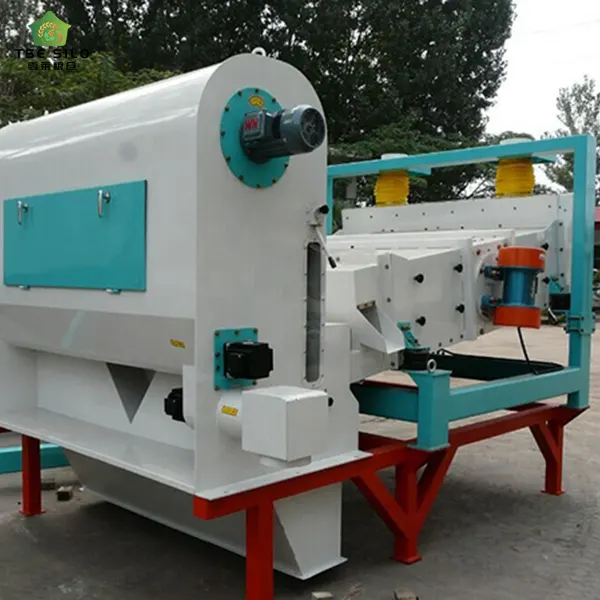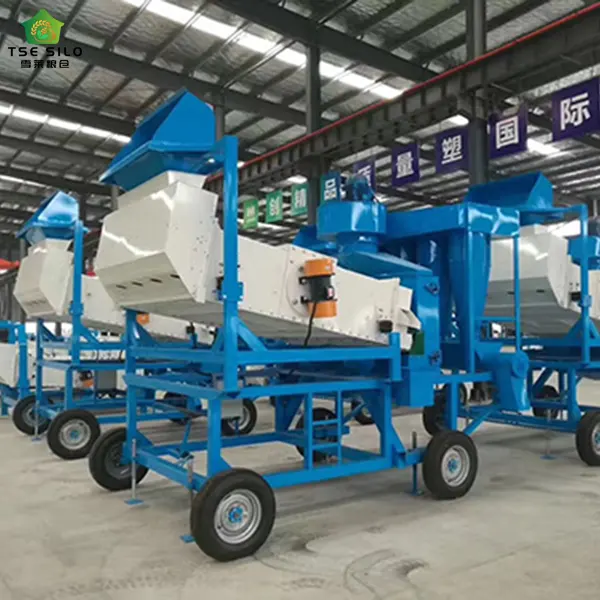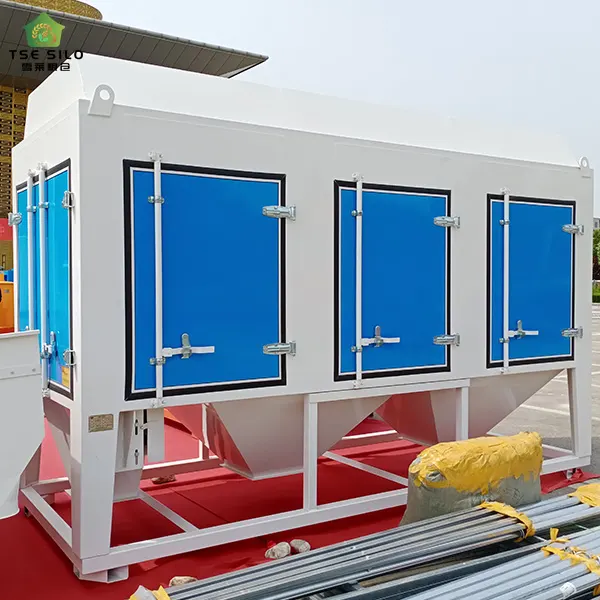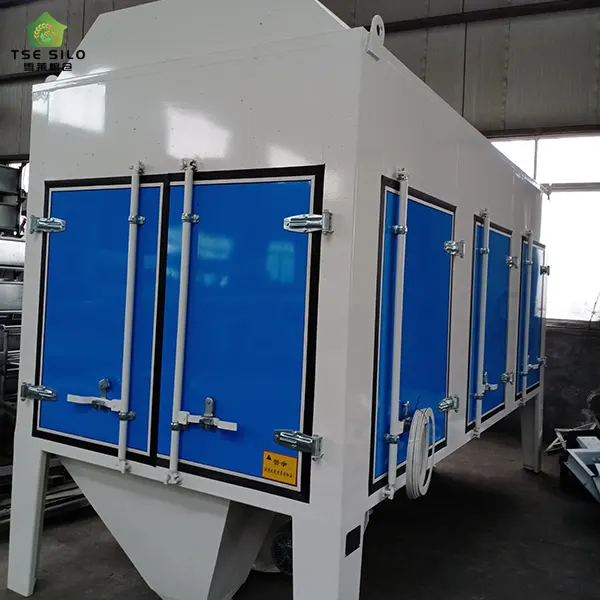The operation of a grain silo is not just about storage, it also includes a series of operations such as grain loading, unloading, drying, moisture-proofing, etc. Its main function is to reduce storage area, improve storage efficiency, and ensure food safety. Therefore, a complete grain steel silo storage system includes multiple basic supporting facilities in addition to the silo itself. The following are the core elements and requirements of supporting steel silo infrastructure:


I. Core Energy Supply
1. Power System:
- Sufficient Capacity: Must meet peak load demands, including:
- Conveying equipment (bucket elevators, belt conveyors, scraper conveyors)
- Cleaning screens and dust removal fans
- Ventilation system (high-power centrifugal fans)
- Grain coolers (if equipped)
- Drying equipment (if equipped, consumes significant power)
- Lighting (inside, outside, and in the work area)
- Control systems (PLC, sensors, monitoring)
- Fire pumps (if equipped with an independent fire protection system)
- Stability and Reliability: Dual-circuit power supply or a backup generator of sufficient capacity is required (especially for large grain storage facilities and strategic reserve depots) to ensure uninterrupted operation of critical systems such as ventilation, temperature control, and monitoring to prevent grain mold.
- Voltage Level: Large equipment (such as drying towers and high-power fans) may require 380V or higher voltages, which requires advance planning and connection. Power Distribution Facilities: Build a standard substation and distribution room, rationally arrange power distribution cabinets and control cabinets, and install lightning protection and grounding.
- Cable Laying: Consider rodent protection, moisture protection, and mechanical damage prevention, preferably using cable trenches or cable trays.
2. Water Supply:
Fire Water:
- Water Quantity and Pressure: Must strictly comply with the requirements of the national "Grain Warehouse Design Code" and "Building Design Fire Protection Code" to ensure sufficient flow and pressure.
- Fire Water Pool/Tank: Typically required, with a capacity sufficient for the duration of the fire.
- Fire Pipeline Network and Fire Hydrants: Cover the entire warehouse area, be clearly located and easily accessible, and regularly maintained.
Production/Domestic Water:
- Dust Suppression Spraying: Install spray devices in dust-prone areas such as grain unloading pits and transfer points.
- Equipment Cooling: This includes water replenishment for cooling towers in drying systems and cooling of air compressors.
- Site Flushing: Maintain a clean site.
- Domestic Water (if office buildings or dormitories are available).
Drainage System:
- Integrate with site drainage to ensure the orderly discharge of wastewater (flushing water, cooling water, etc.) and meet environmental protection requirements.
II. Operation and Logistics System
3. On-site Roads:
- Paved Road Surface: Concrete or asphalt pavement, suitable for heavy-duty grain trucks (over 30-40 tons fully loaded) and frequent operations.
- Width and Turning Radius: Sufficient width (typically ≥7 meters for main roads), with a turning radius suitable for large vehicles.
- Load Capacity: The roadbed and pavement must be designed to withstand heavy-loaded vehicles.
- Circular Driveway/Return Yard: Meet fire safety regulations to ensure fire trucks can reach any building.
4. Operation Site:
- Unloading/Receiving Area: Provide a grain unloading pit (with grating and dust removal) and ample parking and waiting areas to avoid traffic congestion. The surface must be durable and easy to clean.
- Distribution/Loading Area: Provide a loading chute or loading platform with ample space for vehicle turnover. Weighbridge (Truck Scale): Located near the entrance and exit, with access roads and ample waiting areas for weighing.
- Equipment Operation and Maintenance Space: Reserve safe operating and maintenance access for conveyor corridors, elevator towers, cleaning centers, dust removal equipment, etc.
III. Process Equipment Support
5. Grain Receiving and Cleaning System:
- Primary Screen: Removes large impurities (straw, hemp rope, etc.) to protect downstream equipment.
- Vibrating Screen/Gyratory Screen: Finely removes small and medium-sized impurities (silt, small stones, and empty grains).
- Magnetic Separator: Removes ferromagnetic impurities to prevent equipment damage or sparks.
6. Grain Conveying System:
- Bucket Elevator: Primarily used for vertical lifting, considering output, lifting height, crush resistance, and sealing properties.
- Belt Conveyor/Scraper Conveyor: Used for horizontal or inclined conveying, connecting various process points.
- Buried Scraper Conveyor: Commonly used for unloading grain from the bottom of the silo.
7. Ventilation and Temperature Control System:
- Ventilation system: Includes fans (axial or centrifugal), ventilation ducts (above or below ground), and in-silo air ducts (ground troughs or above ground cages). It is the core of ensuring grain storage safety.
- Grain Cooler: Used for temperature control and preservation of grain in hot weather or with high moisture content (optional, but increasingly important).
8. Dust Removal System:
- High-Efficiency Pulse Dust Collector: Install suction hoods and air ducts at all dust-generating points, such as unloading points, conveyor transfer points, elevator heads, and cleaning screens, for centralized dust removal. This is key to meeting environmental requirements, ensuring occupational health, and preventing dust explosions!
- Dust Disposal: Collected dust must be safely handled (e.g., by briquetting, collecting in sealed containers, etc.).


IV. Intelligent Control System
9. Grain Condition Monitoring and Control System:
- Sensor Network: Temperature and humidity (inside the silo and in the atmosphere) sensors, distributed in a layered manner.
- Monitoring and Control Host: Provides data acquisition, storage, analysis, and alarms. Software Platform: Enables remote monitoring, data analysis, and ventilation strategy guidance.
10. Automation Control System:
- PLC/SCADA System: Integrated control of the start/stop, interlocking, and protection functions of conveying equipment, ventilation equipment, dust removal equipment, etc.
- Central Control Room: The core location for centralized monitoring and operations.
11. Security Monitoring System:
- Video surveillance: Covers entrances and exits, key equipment areas, silo roof, and perimeter.
- Access Control System: Controls access.
- Intrusion Alarm: Provides perimeter protection.
V. Fire Protection System
12. Specialized Firefighting Facilities:
- Specialized Firefighting for Grain Silos: In addition to conventional fire hydrants, large steel silo clusters are often equipped with:
- Fixed inert gas (e.g., CO2, N2) fire extinguishing systems: Most effective for suppressing deep-seated grain fires.
- Mobile fire monitors/high-pressure water trucks: Respond to fires outside the silo or assist in extinguishing fires inside the silo.
- Smoke/temperature fire detectors: Provide early warning.
- Firefighting Equipment: Fire extinguishers (dry powder, CO2), fire sandboxes, etc., as required.
VI. Other Supporting Facilities
13. Compressed Air System:
Provides power for pneumatic valves, pulse cleaning of dust collectors, and some control components.
14. Maintenance Workshop and Spare Parts Warehouse:
Used for daily equipment maintenance and emergency repairs, and for storing commonly used spare parts and tools.
15. Office and Living Facilities (as needed):
Office building, duty room, lounge, restroom, etc.
Key Points in Planning and Implementation
- 1. System Integration: All supporting systems (power, transmission, ventilation, dust removal, and control) must be planned and designed as a whole to ensure compatibility and efficient collaboration. Avoid treating the symptoms without addressing the root cause.
- 2. Reserve and Expansion: Fully consider the possibility of future capacity increases and technology upgrades, and reserve interfaces and margins for pipelines, space, and power capacity.
- 3. Professional Design: Designed by a professional organization with extensive experience in grain silo design, particularly in process design and automated control design.
- 4. Quality and Safety:
- Select equipment and materials that comply with national standards and are of reliable quality (especially components related to explosion protection, pressure bearing, and electrical safety).
- Strictly adhere to dust explosion prevention regulations (such as equipment selection, dust removal system design, and electrical explosion protection ratings).
- Fire protection systems must pass fire department inspection.
- 5. Operation and Maintenance Costs: Consider long-term energy consumption (such as the use of high-efficiency motors and inverters), maintenance convenience, and costs during the planning and design phases.
Grain steel silo infrastructure is a critical support system for ensuring the safe, efficient, and stable operation of a grain silo. It goes beyond the simple construction of the silo itself, encompassing the hardware and energy required for the entire process, from grain receiving, cleaning, storage, ventilation, temperature control, to distribution.
Conclusion: Steel silo infrastructure is the "blood vessels" and "nerves" of a grain silo. Its completeness, reliability, and intelligence directly determine the silo's grain storage safety, operational efficiency, operating costs, and personnel safety. Investing the necessary resources for high-level planning and construction is fundamental to ensuring the success and long-term benefits of a steel silo project. Be sure to hire a professional team for overall design and implementation.
Written by
Shandong Shelley Grain Steel Silo Co., Ltd
Editor Jin
www.grainstoragesilos.com
WhatsApp : +86-18653877118
Email : shelley@cnshelley.com






